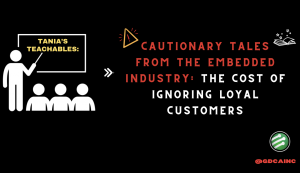The Journey from obsolescence management to life cycle sustainment.
White Papers
Proactive management in all phases of a life cycle is crucial to avoid costly component replacements, ensure critical weapons system readiness, and reduce risks to warfighters.
When it is understood that traditional obsolescence management itself often starts too late in a program’s life cycle, we see the need to address ongoing risk from a different angle.
Critical Thoughts
Tania’s Teachable: Cautionary Tales from the Embedded Industry: The Cost of Ignoring Loyal Customers
New Episode Alert: Lessons from a Market Leader’s Misstep In our latest episode of “Tania’s Teachable,” we explore a compelling case study recently featured in EE Times Europe. The episode […]
Read MoreJust because you have the TDP doesn’t mean you can build the board
Recently, one of the ways in which we’ve seen end-use customers try to combat electronics obsolescence is by getting the technical data (TDP) of the required circuit board from the […]
Read MoreThe New Kids on the Supply Chain Block
Electronics obsolescence causes far bigger shockwaves across supply chains than most people realize. The domino effect typically starts with the discontinuation of a component on the circuit board, and then […]
Read MoreGDCA Media
News
NAI, GDCA team up to ensure continued support for U.S. Navy Evolved Sea Sparrow Missile (ESSM) program
BOHEMIA, New York and LIVERMORE, Calif. Rugged embedded computing supplier North Atlantic Industries (NAI) and long-term embedded support provider GDCA Inc. announced the successful transfer of NAI’s venerable 64C1 & 64D1 legacy product lines, […]
Negative Case Study: An Embedded OEM’s Disastrous Disengagement
This case study reflects the pitfalls of neglecting legacy customers during major transitions, dissecting missteps and missed connections.
A look at the difference between OEMs and LEMs–and why LEMs are so important for OEMs
Tools
🔙 #FlashbackFriday 🔙
Join Tania Scroggie in "How to EOL a product | Tania's Teachable Moments" 📺🌟
Learn how to gracefully sunset a product while keeping customers happy. Gain insights from Tania, an embedded legacy expert at GDCA in Livermore, CA.... https://t.co/ddEVHl1Z3C
— GDCA (@GDCAinc) June 23, 2023






